
- Adult moths are about 3/8-inch (8 to 10mm) long when at rest and have a wing spread of about 1/2 to 3/4 inch (18 to 20mm)
- About 3/8 inch (10mm) long at rest; wing spread is about 5/8 inch (14mm).
- About 3/8 inch (10 mm) long at rest; wing spread is about 5/8 inch (14 mm).
- Indian meal moth adult has wingspread of about 5/8-3/4 in (16-20 mm).
- Also, the head and thorax are reddish-brown and the hind wings gray.
- Bronze-colored wings. The Indian meal moth has pale gray wings, but the front wing is reddish brown and coppery on the outer two-thirds. Mature larva is usually dirty white, but may vary to greenish, pinkish, or brownish, depending on the food it eats; head region is yellowish to reddish brown.
Identification
- When viewed from above with the wings folded over the back, the outer
2/3 of the wing appears reddish-brown or bronze
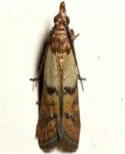 colored "at the wing
tips" while the inner 2/3 of the wing "at the basal portion" is light
gray to ochre-yellow. The larvae or "caterpillars" are about 2/3 inch
(12.5mm) when mature. Brown-headed larvae are dirty white, sometimes
tinged pink or green. Larvae are quite active and molt four to seven
times before pupating. Pupae are reddish-brown and about 3/8-inch long.
Eggs are grayish to dirty white and from 0.3 to 0.5mm long.
colored "at the wing
tips" while the inner 2/3 of the wing "at the basal portion" is light
gray to ochre-yellow. The larvae or "caterpillars" are about 2/3 inch
(12.5mm) when mature. Brown-headed larvae are dirty white, sometimes
tinged pink or green. Larvae are quite active and molt four to seven
times before pupating. Pupae are reddish-brown and about 3/8-inch long.
Eggs are grayish to dirty white and from 0.3 to 0.5mm long.
- The Indian meal moth is a handsome moth with a wing expanse of
nearly three-quarters of an inch. It is easy to distinguish from other
grain pests by the peculiar markings of the forewings; they are reddish
brown with a copper luster on the outer two-thirds, but whitish gray on
the inner or body ends. The hind wings lack distinctive markings and are
more or less uniformly gray. Adults can be seen resting on the grain
surface or grain bin walls. The adults fly at night and are attracted to
lights.
- Characteristics: Adult has hind wing that is broader than the front wing and fringed with long hair-like scales. Larva has 5 pairs of well-developed prolegs on abdomen, each with hooks.
- The Indian meal moth originated in the Old World, but now occurs around the world.
- The Indian meal moth larva's home is your food!
- The adult moths usually fly at night and lay eggs on food such as grain, dried food, and especially pet food.
- As long as the temperature within a grain bin or building where
grain is stored remains above 50×F, the Indian meal moth
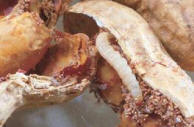 can survive
and reproduce. A typical life cycle (egg to adult) is completed in
forth to fifty-five days. A potential for seven to nine generations
per year exists; however, because of cool temperatures during the
winter months fewer generations are
can survive
and reproduce. A typical life cycle (egg to adult) is completed in
forth to fifty-five days. A potential for seven to nine generations
per year exists; however, because of cool temperatures during the
winter months fewer generations are
- A mature female lays 100 to 300 eggs on food material, either
singularly or in groups of twelve to thirty. Larvae begin to hatch
in two to fourteen days, depending on environmental conditions.
Newly hatched larvae feed on fine materials within the grain and are
small enough to pass through a sixty mesh screen. For this reason,
it is difficult to exclude larvae from most packaged foods and
grain.
- The life cycle and habits of this pantry pest is similar to other moths infesting stored products. Eggs are laid on or near the food. A female moth may deposit from 40 to 350 eggs. After hatching, the small caterpillars begin spinning silken threads in the infested food material. They feed for about two weeks before becoming full grown. They crawl up to the surface of the food material or often up walls and pupate within a cocoon. The adult emerges in about 30 days. The entire cycle requires about six weeks and there are from 4-6 generations per year
- The Indian meal moth is one of the most common and troublesome of
the moths infesting stored products. The caterpillar
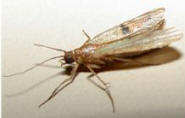 stage of this
insect will feed on a variety of grains, meal, breakfast foods, dried
nuts, seeds, chocolate, powdered milk, and especially dry pet foods.
Infested material may be more or less webbed together. Small two-colored
moths (gray and reddish-brown) will also be seen flying about the
infested area.
stage of this
insect will feed on a variety of grains, meal, breakfast foods, dried
nuts, seeds, chocolate, powdered milk, and especially dry pet foods.
Infested material may be more or less webbed together. Small two-colored
moths (gray and reddish-brown) will also be seen flying about the
infested area.
- Damage is caused by the larvae spinning silken threads as they feed
and crawl, thus webbing food particles together. Besides infesting all
cereal food products and whole grains, larvae also feed on a wide
variety of foods and feeds such as dried fruits, powdered milk,
cornmeal, flour, raisins, prunes, nuts, chocolate, candies, health food
and seeds, bird seed, dog and cat food, fish food, graham crackers,
dried red peppers, pastas, etc.
- Direct damage to grain is the result of larvae feeding on the seed
germ. In grain to be sold for human or animal consumption, meal moth
feeding reduces the dry weight. At the same time, grain weight may
actually increase because of water absorption; with an increase in water
content mold can become a problem. The biggest reduction in value is the
result of contamination by larvae that leave droppings and silken webs
in the grain. The presence of live insects and insect parts can result
in dockage of the grain when sold.
- Adults cause no damage. Larvae produce the web material found in
food, such as dried fruits, whole wheat and graham
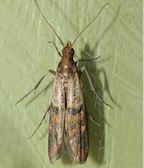 flours, cornmeal, and
shelled or ear corn.
flours, cornmeal, and
shelled or ear corn.
- The Indian meal moth is one of the most common and troublesome of the moths infesting stored products. The caterpillar stage of this insect will feed on a variety of grains, meal, breakfast foods, dried nuts, seeds, chocolate, powdered milk, and especially dry pet foods. Infested material may be more or less webbed together. Small two-colored moths (gray and reddish brown) will also be seen flying about the infested area.
- Prevention is the best strategy to avoid Indian meal moth
problems. Proper sanitation will help minimize the need to use
pesticides. Good sanitation practices involve the removal of old grain
and dust in and around the grain bin before storing new grain. This
includes removing grain from corners, floors, and walls. Any grain
remaining when a bin is emptied can harbor insect infestations which
will move into the new grain.
- Another tactic which can be used to help prevent build-up of insect
populations in stored grains is to periodically run the
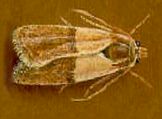 grain dryer fan.
Increased air flow through the grain mass helps control the grain
temperature and reduces moisture build-up, creating an unfavorable
environment for the insects.
grain dryer fan.
Increased air flow through the grain mass helps control the grain
temperature and reduces moisture build-up, creating an unfavorable
environment for the insects.
- Proper and consistent sanitation of the bins before the new grain is
stored will usually protect grain up to six months. If the grain is to
be stored for over six months, a residual insecticide application should
be applied to the floor and structure walls. After the bin is filled, a
residual spray should be applied to the grain surface.
- Fumigation should be considered only if an emergency exists. Because fumigants are extremely hazardous, they must be handled with care.
- Control of this pest begins with the location of the infested
food. A thorough clean up, using a vacuum cleaner to get into the
cracks and crevices, will control this pest.
- Before purchasing, examine foods such as milled cereal products,
flour and dried fruit for infestations. Examine broken and damaged
packages and boxes to avoid bringing stored pests accidentally into
the home. Check the packaging date to ensure freshness.
- Purchase seldom-used foods in small quantities to prevent long
storage periods of a month or more. Susceptible material stored for
six months or more, especially during the hot summer months, has the
possibility of developing into serious infestations. Store
susceptible foods in insect-proof containers of glass, metal or
plastic ware with tight-fitting lids, ideally screw-type. Highly
susceptible foods, such as spices, can be kept in the refrigerator
and other foods in the freezer. Always use older packages first, and
inspect frequently to avoid any spillage which might attract
insects. Properly ventilate the storage area to discourage
moisture-loving pests.
- Foods of questionable infestations or even lightly infested can
be super cooled or superheated. Place exposed or suspect
 foods in a
freezer at 0°F. for four to seven days or in a microwave oven for
five minutes or in a shallow pan or tray in the oven at 140°F for
one hour or 120°F for two hours. Spread the material thinly to
permit effective cold or heat penetration to kill all life stages of
the pest. If in the oven, stir food periodically to prevent possible
scorching. Dried fruits can be placed in cheese cloth bags and
dipped into boiling water for six to ten seconds to kill external
pests. However, seeds saved for planting may have the germination
reduced after superheating or cooling. Sifting the food material
will remove possible insect fragments and any remaining will not
cause harm if consumed. After insects are killed, contaminated food
might be used outdoors during winter months for bird feed.
foods in a
freezer at 0°F. for four to seven days or in a microwave oven for
five minutes or in a shallow pan or tray in the oven at 140°F for
one hour or 120°F for two hours. Spread the material thinly to
permit effective cold or heat penetration to kill all life stages of
the pest. If in the oven, stir food periodically to prevent possible
scorching. Dried fruits can be placed in cheese cloth bags and
dipped into boiling water for six to ten seconds to kill external
pests. However, seeds saved for planting may have the germination
reduced after superheating or cooling. Sifting the food material
will remove possible insect fragments and any remaining will not
cause harm if consumed. After insects are killed, contaminated food
might be used outdoors during winter months for bird feed.
- Careful sanitation is the best method to avoid stored product
pests. After removing all food, food packages, utensils, dishes,
etc. from the cupboard, shelves or storage area, use a strong
suction vacuum cleaner with proper attachments to clean up all
spilled foods (toaster crumbs, cornmeal, bits of pet food, raisins,
etc.) from cracks and crevices, behind and under appliances and
furniture. Pull out heavy appliances from the wall and scrub with
soap and hot water. The ability of these insects to find a small
amount of food and survive is amazing. After shelves are thoroughly
dry, cover with clean, fresh paper or foil before replacing with
food or cooking utensils. Remove and destroy any cocoons found in
cupboards and other sites.
- Locate the source of infestation and quickly get rid of it.
Dispose of heavily infested foods in wrapped, strong, plastic bags
or in sealed containers for garbage disposal service or bury deep in
the soil if permitted and practical. If detection is made early, it
may be the only material infested and the problem is solved. Be sure
to carefully examine seldom-used foods, especially in least
disturbed storage areas. One can spread suspected foods on a tray to
determine whether infestation is widespread. Inspect unopened
cardboard boxes since pests can chew into these boxes and plastic
inserts.
- Pheromone traps are commercially available for inspection,
monitoring, and pinpointing infestations of adult Indian meal moths.
Insects use pheromones to communicate with each other, and are
natural compounds created in the insect body. Many have been
isolated in the laboratory and now used to lure insects into sticky
traps.
- Adult moths live only five to seven days with their major
function to reproduce. Male moths are attracted to pheromone scent
(sex-attractant). Traps can be hung indoors next to the ceiling,
behind shelves, etc. to capture moths on a sticky board. In food
warehouses, some use five traps per 1,000 square feet. A few
well-placed traps (about $6.00 each) can detect moths. About one in
eight Indian meal moths that approach a pheromone trap enters it.
The trap alone is a "monitoring tool" not a control method.
- On-farm grain storage, particularly corn, is increasing in
Pennsylvania. Stored-grains offer compact food sources for a
 number
of insect pests. Good management practices are aimed at excluding
these insects while maintaining grain quality. The longer grain is
held in storage, the greater the need to maintain good management
practices such as sanitation and residual sprays. When proper
management is ignored, populations of insects which have been
feeding and reproducing in grain residues are free to infest new
grain. Once in the new grain, the insects continue to eat and
reproduce. Substantial numbers of grain infesting insects can reduce
the value of grain, or render it unfit for processing or feeding.
Indian meal moths in the grain result in reduced grain weight and
dockage because of contamination by fecal material and webbing.
number
of insect pests. Good management practices are aimed at excluding
these insects while maintaining grain quality. The longer grain is
held in storage, the greater the need to maintain good management
practices such as sanitation and residual sprays. When proper
management is ignored, populations of insects which have been
feeding and reproducing in grain residues are free to infest new
grain. Once in the new grain, the insects continue to eat and
reproduce. Substantial numbers of grain infesting insects can reduce
the value of grain, or render it unfit for processing or feeding.
Indian meal moths in the grain result in reduced grain weight and
dockage because of contamination by fecal material and webbing.
- Indian meal moth larvae and adults in flight are often mistaken for clothes moths.
- Inspect flour, grains, for larvae and adults, but remember pupation takes place outside infested foodstuffs.
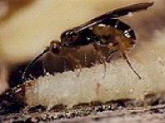
- Heat infested material to 150 degrees F (66 C) for 20 minutes, in shallow tray with oven door propped open a few inches, stirring every few minutes.
- Place decorative items made from plants in a (non-self-defrosting) freezer at 0 degrees F (-18 C) for 4 days.
- Transfer stored grain into airtight plastic containers.
- Use vacuum or aerosol to remove exposed adult insects. Use residual insecticide in pantry cracks and crevices.
- Use only registered pesticides, read entire label, heed all directions, restrictions and precautions
- Inspect incoming items.
- Supply ventilation.
- Keep buildings in good physical condition to reduce entry.
- Quickly remove spilled grain.
- Keep facility clean, maintain grounds.
- Store pallets 18 inches away from walls
- Replace torn package
- Rotate food and nonfood stock; move out oldest stock first.
- Identify species correctly.
- Use light traps and/or electrocuters.
- Fumigate if appropriate.
- Use insect pheromone and/or baited monitoring devices.
- Use only registered pesticides. Read entire label, and follow all directions, heeding restrictions and precautions.
- Control of any stored food pest requires locating and eliminating infested item(s). All potentially infested foods should be checked.
- The insects may be in unopened boxes or containers. Infested items can be thrown away or salvaged by freezing for 1 week or heating in a 140 degree oven for 15 minutes.
- Control of this pest begins with the location of the infested food. Empty and thoroughly vacuum clean cupboards or shelves holding infested items, paying particular attention to cracks and corners.
- Vacuum cleaning picks up hiding insects and spilled or infested material. Empty the vacuum cleaner or discard the vacuum cleaner bag after use to prevent reinfestation. Do not use insecticides for controlling these or other insects in stored food cupboards. Washing shelves with detergent, bleach, ammonia or disinfectants will not have any effect on these pests since the female only lays its eggs on suitable food.
- Removing the infested material and thorough cleaning with a vacuum is usually sufficient. As a precaution against reinfestation, store susceptible foods in tightly sealed glass, metal or heavy plastic containers or in the refrigerator or freezer. Always inspect susceptible food items before purchasing.
Biological Control
- The Indian meal moth and other agricultural insect pests
have developed widespread resistance to Bacillus thuringiensis, or
 Bt. The same pests are also developing resistance to currently used
pesticides, and regulatory restrictions are limiting the use of
others. This makes these pests highly suitable for control with
natural predators. The Indian meal moth can be controlled by the parasitoid, Bracon hebetor. (Pictured below attacking meal moth
larvae).
Bt. The same pests are also developing resistance to currently used
pesticides, and regulatory restrictions are limiting the use of
others. This makes these pests highly suitable for control with
natural predators. The Indian meal moth can be controlled by the parasitoid, Bracon hebetor. (Pictured below attacking meal moth
larvae).
- Bracon hebetor is a minute parasitic wasp that preys exclusively
on Indian meal moth and almond moth larva external to grain. It is
well suited to large bulk storage facilities where large numbers of
moths are present to provide the wasp with ample food and breeding
sources. In trials in animal food warehouses, and feed stores in the
Mat-Su Valley, this wasp provided biological control of the Indian
meal moth for over six months with a single release.
- The B. hebetor wasp is a good bio-control agent partly because it feeds rapidly and has gut enzymes that quickly break down two major blood proteins in moth larvae. It is commercially available from IPM of Alaska for non-toxic pest management programs in Alaska. Supplies are limited since no artificial food source to rear the larvae are yet available.
Trapping
- Sex pheromone lures and sticky traps will capture small
numbers of adult moths. Insects use pheromones to communicate with
each other, and are natural compounds created in the insect body.
Many have been isolated in the laboratory and now used to lure
insects into pressure sensitive adhesive.
- Adult moths live only five to seven days with their major
function to reproduce. Only the male moths are attracted to the
pheromone scent (sex attractant). Traps can be hung indoors next to
the ceiling, behind shelves, etc. to capture moths on the sticky
board. In warehouses, use five traps per 1,000 square feet. A few
well placed traps can detect moths, but will not control an
infestation without discarding the source.
- About one in eight Indian meal moths that approach a pheromone
trap enters it. They are most useful as a monitoring tool to
determine when infested material is present. Pheromone traps are
available for inspection, monitoring, and pinpointing infestations
of adult Indian meal moths from IPM of Alaska.
- When insects are detected in food products, attention should
first be given to identifying all sources of infestation within the
home. Check all susceptible food items in cupboards, paying
particular attention to items that have not been used for a long
period of time. Bird seed, dry dog food, fish food and other such
materials are commonly infested items that should not be overlooked.
- The physical presence of the insects is the most obvious means
of detecting areas of infestation. The presence of webbing is an
easy means of detecting items infested by Indian meal moth. Larvae
wandering from the infested food items are a symptom that is
commonly first detected in the fall of the year. Also, the small
brown moths may be seen fluttering about, usually between October
and January.
- Items infested by Indian meal moth should be immediately
discarded or temperature treated in a manner to kill the insect.
Cold treatment can involve putting infested items in deep freeze for
3-4 days. Effectiveness of this treatment is improved by alternating
freezing treatments with a periodic rewarming to room temperatures
is particularly effective for control. High temperature treatments
involve oven heating at 133-1400 (F) for 20 minutes. Injury to the
food is possible with excessively high temperature treatments.
- Heat or cold treated objects are capable of being reinvested so
they should be kept in the refrigerator or stored into tight fitting
containers until household infestations have been eliminated. Adult
Indian meal moths deprived of food might live 3 to 5 weeks. Often
bleach or other sanitizing agents are used during this clean up
phase. These can kill a few exposed insects and eggs. However, they
have not residual effects and provide little additional insect
control unless the spilled foods are completely eliminated.
- As a routine precaution, materials suspected of harboring developing meal moth larvae should be treated by freezing after purchase. Purchasing smaller amounts of food and rapidly using food products after purchase also prevents infestations from being established from insects brought in on the food.